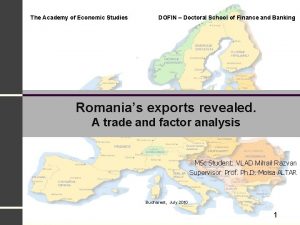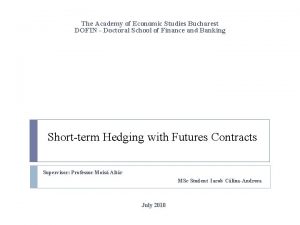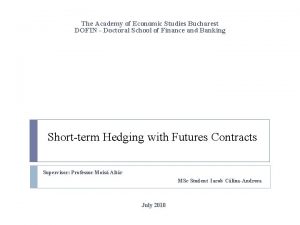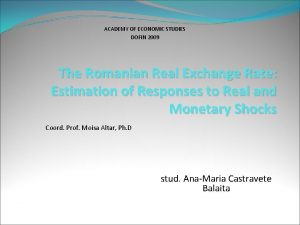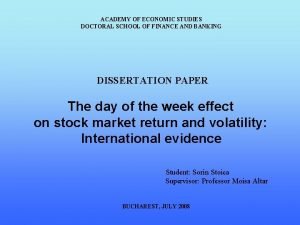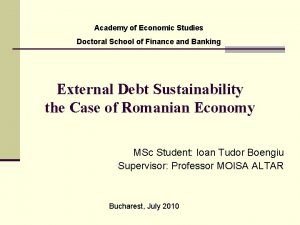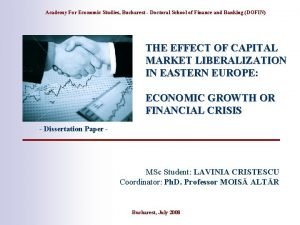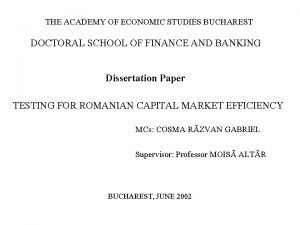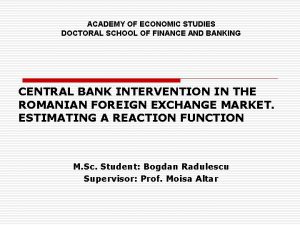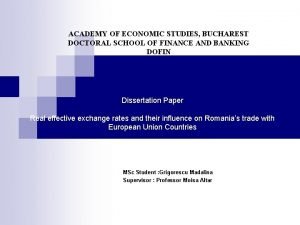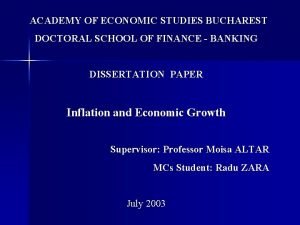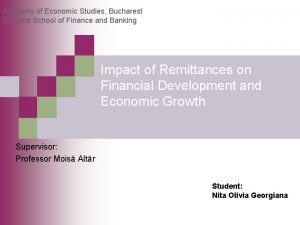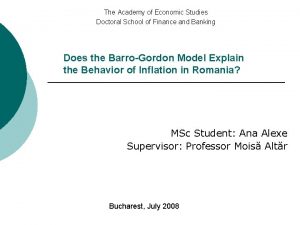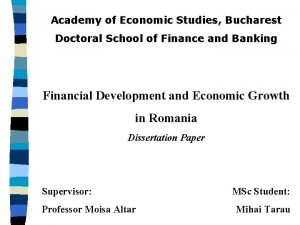The Academy of Economic Studies DOFIN Doctoral School


























- Slides: 26

The Academy of Economic Studies DOFIN – Doctoral School of Finance and Banking DETERMINANTS OF SPREADS OF ROMANIAN SOVEREIGN BONDS - an application on the EMBIG spreads – Student: BERBECARU CLAUDIA-FLORIANA Supervisor: Professor MOISĂ ALTĂR Bucharest, July 2008

DETERMINANTS OF SPREADS OF ROMANIAN SOVEREIGN BONDS n In last years there was a rapid compression in the spreads of sovereign bonds issued by Emerging Economies n The compression in spreads was driven both by domestic fundamentals but also by the developments in the risk appetite of investors on the international markets n For instance, decrease in the EMBIG spreads for Romania came hand in hand with important progresses in the economy as reflected by the improved sovereign ratings from S&P EMBIG Composite, EMBIG Romania and Credit Rating Outlook for Romania

DETERMINANTS OF SPREADS OF ROMANIAN SOVEREIGN BONDS n Developments in the risk appetite of investors on the international markets were also important for the sovereign spreads n EU accession had also an impact on the spreads for CEE countries

THE MODEL The spreads of sovereign bonds for Emerging Economies are thought to reflect the default risk of these countries n They should be modeled as a function of the probability of default and of the loss given the default (or the expected recovery) n n Most empirical analises use the following reduced-form equation:

DATA USED IN ANALYSIS Number of countries: Period of analysis: 11 Emerging Economies May 2002 – April 2008 EMBIG spreads n They are computed by JP Morgan on daily basis as the difference between the yields of sovereign bonds issued by Emerging Economies and the yield for a bond issued by a a developed benchmark economy n The spreads of sovereign bonds for Emerging Economies are thought to reflect the default risk of these countries n EMBIG price indexes are used in the last part of the paper to estimate volatility, comovements and spillover effects

DATA USED IN ANALYSIS Credit Rating Outlook Index (CROI) n Converts the sovereign ratings of S&P on a numerical (cardinal) scale n The CROI is used as proxy for the domestic fundamentals n We use the CROI computed by Hartelius and others (2008) which takes into account both the ratings and the oulooks for the ratings n The HP filtered series (ʌ=15) is used the estimations

DATA USED IN ANALYSIS Volatility index of S&P 500 (VIX) The Chicago Board Options Exchange Volatility Index (VIX) is a key measure of market expectations of near-term volatility (30 days) conveyed by S&P 500 stock index option prices n Proxy for risk appetite in the global markets n

DATA USED IN ANALYSIS Other series taken into account, but not used in the final model 3 -months futures on the FED funds rate - used n volatility of the diference between the 3 -months futures on the FED funds rate and the FED funds rate n Unit root tests Unit root test on the individual series showed that the series are I(1) n Panel unit root tests showed also that series are I(1) n

EMPIRICAL MODEL Testing for cointegration No cointegration was found between the data when using only data for Romania n Panel cointegration tests (Pedroni and Kao) showed that there is a cointegration relationship between the log of EMBIG spreads, the log of CROI index, and the log of VIX n Estimation methods n To estimate the lon-run relationship between the variables, we use two models: n n A panel model with fixed effects The pool mean group (PMG) estimator of Pesaran, Shin and Smith (1997)

PANEL MODEL WITH FIXED EFFECTS – ESTIMATION RESULTS

PANEL MODEL WITH FIXED EFFECTS – ESTIMATION RESULTS § The Wald test rejects the null hypothesis that the coefficient of the VIX is the same across the countries § The tests rejects the null hypotesis that the fixed effects coefficents are the same across countries

PANEL MODEL WITH FIXED EFFECTS – ESTIMATION RESULTS n Given that the variables are I(1) and cointegrated, the residuals can be considered as deviations from the long-run equilibrium

PANEL MODEL WITH FIXED EFFECTS – ESTIMATION RESULTS n There is a high similarity between Romania and Bulgaria which might be explained by the EU accession process: n Spreads increased above the equilibrium level in 2003 when the EU decided not to include Romania and Bulgaria in the 2004 enlargement wave n Spreads decreased towards the equilibrium level in 2004 when the 2007 accession target was announced n Spreads felt below the equilibrium level in 2007 after the EU accesion n In April 2008 Romanian embig spreads were below the equilibrium level despite the fact they increased starting mid-2007

POOL MEAN GROUP ESTIMATOR OF PESARAN, SHIN AND SMITH (1997)

POOL MEAN GROUP ESTIMATOR OF PESARAN, SHIN AND SMITH (1997) n Schwarz Criteria selected an ARDL (2, 0, 1) model for Romania

POOL MEAN GROUP ESTIMATOR OF PESARAN, SHIN AND SMITH (1997) n Coefficients in the long-run relationship for the 11 countries in the pool model

POOL MEAN GROUP ESTIMATOR OF PESARAN, SHIN AND SMITH (1997) n Panel with fixed effects estimation: n Pool mean group estimator results:

MAIN PRACTICAL IMPLICATIONS OF THE MODEL n The spreads for the Romanian sovereign bonds decreased by 225 bp between May 2002 and April 2008. The estimated model, based on the long-run equilibrium relationship, implies only a decrease of 51 bp. n The higher decrease in the effective spreads is due to the fact that the Romanian bonds were undervaluated in 2002 (the spreads were above their equilibrium level) and they were overvaluated in April 2008 (the spreads were below their equilibrium level). n The 51 bp decreased based on the equilibrium level is due exclusively to the fundamentals (as reflected by the decrease in the S&P sovereign rating), while the external factors had no impact during this interval. This is because following the crisis on the international markets the VIX index returned to the same level as in 2002, which means that the investors started to price appropriately the risk. n In the long run, a country cannot bet on the external factors to reduce its borrowing costs. Rather, it should implement appropriate domestic policies in order to improve domestic fundamentals.

CO-MOVEMENTS AND SPILLOVER EFFECTS IN THE DAILY RETURNS OF SOVEREIGN BONDS n We test for the existence of a co-movement in the prices of sovereign bonds and for the existence of spillover effects between the Emerging Countries from Europe n We use daily returns from May 2002 to May 2008 for 6 countries: Poland, Hungary, Slovakia, Romania, Bulgaria, Croatia n To test for co-movements we use the permanent components of the conditional variance obtained from univariate Component GARCH (1, 1) models:

CO-MOVEMENTS AND SPILLOVER EFFECTS IN THE DAILY RETURNS OF SOVEREIGN BONDS Estimation results:

CO-MOVEMENTS AND SPILLOVER EFFECTS IN THE DAILY RETURNS OF SOVEREIGN BONDS n There is a high similarity especially between the permanent components for conditional volatility for Romania, Bulgaria, and Croatia Permanent components of the conditional standard deviations Correlation coefficients

CO-MOVEMENTS AND SPILLOVER EFFECTS IN THE DAILY RETURNS OF SOVEREIGN BONDS n Principal components analysis for the permanent components of conditional volatility

CO-MOVEMENTS AND SPILLOVER EFFECTS IN THE DAILY RETURNS OF SOVEREIGN BONDS n In order to test for spillover effects we reestimate the CGARCH model using in the equation for the permanent component of the volatility for a country the lagged estimated permanent components for the other countries n There are spillover-effects especially both to and from Romania

CONCLUSION n The Credit Rating Outlook Index (CROI) and the volatility index VIX explain well the developments in the spreads of sovereign bonds n There is a large similitude between the deviations of spreads from the level implied by the longrun relationship in the case of Bulgaria and Romania, which we explain by the EU accession process of these two countries. n We find also a comovement in the volatility of daily returns of CEE sovereign bonds, with spillover effects especially between Bulgaria and Romania. The co-movement is located at the level of the permanent component of the conditional volatility, which means that it is related to fundamental factors. n In the long run, a country cannot bet on the external factors to reduce its borrowing costs. Rather, it should implement appropriate domestic policies in order to improve domestic fundamentals. n Additional research is welcomed. For instance, modeling the impact of EU accession on the spreads of CEE sovereign bonds is challenging from an econometric point of view given that this is an unobservable variable. Also, alternative estimation methods might be used in order to check the robustness of the empirical results.

REFERENCES

REFERENCES
 The bucharest university of economic studies ranking
The bucharest university of economic studies ranking Eui doctoral programme
Eui doctoral programme Brandman doctoral program
Brandman doctoral program Nsf doctoral dissertation improvement grant
Nsf doctoral dissertation improvement grant Umbc doctoral programs
Umbc doctoral programs Doctoral initiative on minority attrition and completion
Doctoral initiative on minority attrition and completion College doctoral ubfc
College doctoral ubfc Power point tesis doctoral medicina
Power point tesis doctoral medicina South west doctoral training partnership
South west doctoral training partnership Nsf dissertation improvement grant
Nsf dissertation improvement grant Csu doctoral incentive program
Csu doctoral incentive program Paradigm shift from women studies to gender studies
Paradigm shift from women studies to gender studies Academy of lymphatic studies
Academy of lymphatic studies Georgia academy for economic development
Georgia academy for economic development Economic growth vs economic development
Economic growth vs economic development What is economic growth and development
What is economic growth and development Economic systems lesson 2 our economic choices
Economic systems lesson 2 our economic choices Hát kết hợp bộ gõ cơ thể
Hát kết hợp bộ gõ cơ thể Lp html
Lp html Bổ thể
Bổ thể Tỉ lệ cơ thể trẻ em
Tỉ lệ cơ thể trẻ em Voi kéo gỗ như thế nào
Voi kéo gỗ như thế nào Thang điểm glasgow
Thang điểm glasgow Chúa sống lại
Chúa sống lại Các môn thể thao bắt đầu bằng tiếng đua
Các môn thể thao bắt đầu bằng tiếng đua Thế nào là hệ số cao nhất
Thế nào là hệ số cao nhất Các châu lục và đại dương trên thế giới
Các châu lục và đại dương trên thế giới



























